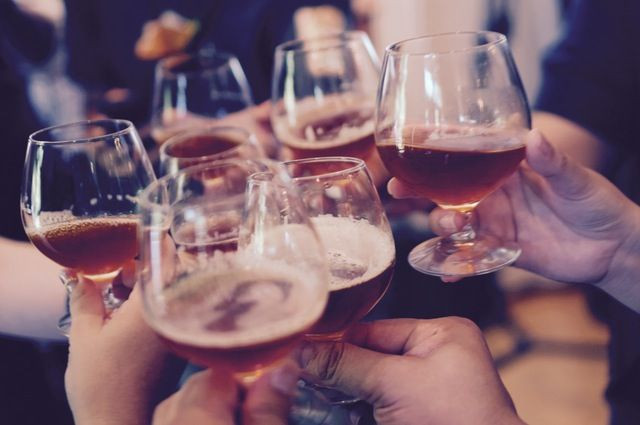Scientists Discover 'No-Go' Brain Cells That Tell People When It's Time To Stop Drinking

Going out for "just one drink" during Happy Hour sometimes turns into two, three, or four drinks hours later. The urge to seek more alcohol, even when we've had more than enough rounds, comes down to two neurons in the brain. According to a recent study published in the journal Biological Psychiatry, the activation of the neuron "D1" will determine whether one drink leads to two, while the activation of "D2" will tell us to stop drinking.
Previous research has found alcohol consumption alters the physical structure and function of medium spiny neurons — D1 and D2 — in the dorsomedial striatum, the part of the brain that contribute directly to decision making. D1 neurons are informally part of a "go" pathway in the brain, while D2 neurons are in the "no-go" pathway. In the context of alcohol, when D2 neurons are activated, they inhibit drinking behavior, telling us to stop, wait, and do nothing.
“At least from the addiction point of view, D2 neurons are good,” said Jun Wang, MD, PhD, the corresponding author on the paper and assistant professor in the department of neuroscience and experimental therapeutics at the Texas A&M College of Medicine, in a statement.
In the study, Wang and her colleagues trained mice to consume alcohol using a two-bottle choice drinking procedure — one bottle filled with alcohol, and the other with water. Slice electrophysiology, the study of a synapse or neural circuit in isolation from the rest of the brain, was used to measure the strength of D1 and D2 neurons in alcohol-drinking mice and their sober controls. Researchers also used several other approaches to manipulate neuronal activity, and then measured their consequences on alcohol consumption in the mice.
The findings revealed that repeated cycles of excessive alcohol intake, followed by abstinence, actually changed the strength of these neuronal connections. This means D2 signals became less powerful, and trained the mice to seek alcohol. In addition, D2 become deactivated when they drank too much, even in mice without alcoholism. D2 deactivation means there is nothing to tell them to stop drinking, so this leads them to drink more.
“Think of the binge drinking behavior of so many young adults,” said Wang in a statement. “Essentially they are probably doing the same thing that we’ve shown leads to inhibition of these so-called ‘good’ neurons and contributes to greater alcohol consumption.”
These results have implications when it comes to the complicated disease of alcoholism. Researchers were able to manipulate the activity of these neurons to change the rodents' drinking behavior who were "trained" to seek alcohol. Therefore, by activating D2 neurons, they were able to decrease alcohol consumption, and the more D2 neurons were activated, the greater the effect they observed.
Whether it’s an acute withdrawal from alcohol or prolonged abstinence, a recent study found when an alcoholic stops drinking, the brain’s ability to use dopamine — a chemical messenger that activates the brain’s reward center — changes, altering the way the reward system is wired. This is why the dopamine response is significantly reduced in alcoholics, leading them to need to drink more in order to get drunk. In the brains of deceased alcoholics, there was a reduced presence of D1 receptors, sites on the membranes of neuronal cells that dopamine binds to, causing the neurons to become excited.
A reduction in these receptor sites means the brain is less responsive to dopamine, which explains why moderate amounts of alcohol fail to satisfy an alcoholic’s needs. The researchers note the brains of the deceased alcoholics had no reduction in D2 receptor sites. This suggests once alcohol affects the brain’s reward center, D2 neurons weaken no matter their presence in the brain.
Human testing still must be done to validate Wang’s findings, but the researchers feel hopeful that medications, electrical stimulation, or another method might be able to activate D2 neurons, and prevent alcoholics from wanting a drink.
Source: Cheung Y, Huang CCY, Ma T et al. Distinct Synaptic Strengthening of the Striatal Direct and Indirect Pathways Drives Alcohol Consumption. Biological Psychiatry. 2016.



























